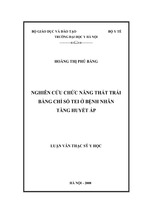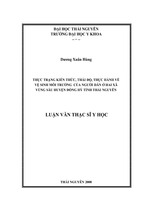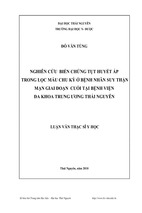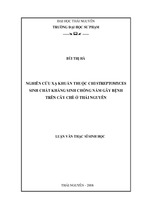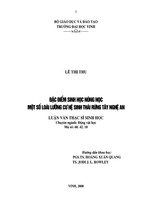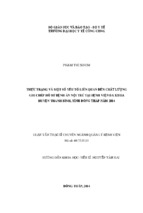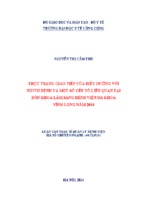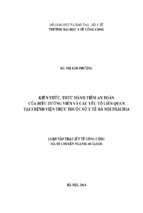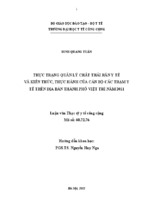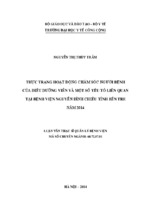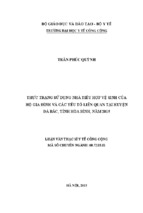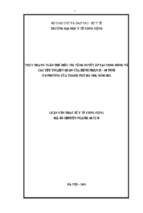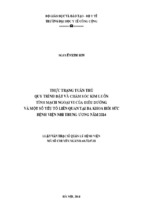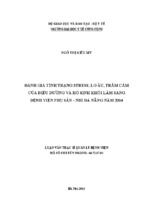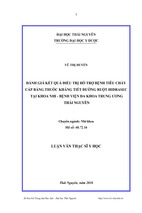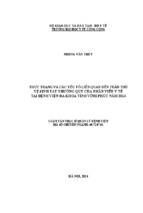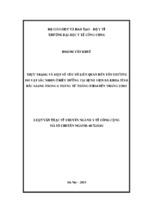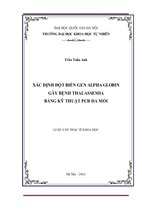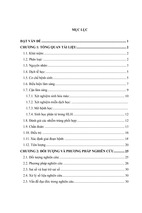A Study of Vibration Control of Truck Seat Suspension
System
A thesis submitted in fulfillment of the requirements for the Degree of Master of
Engineering
Yuli Zhao
Bachelor of Automotive Engineering & Mechanical Engineering, RMIT University, 2014
School of Engineering
College of Science, Technology, Engineering and Maths
RMIT University
September 2020
Declaration
I certify that except where due acknowledgment has been made, the work is that of the author
alone; the work has not been submitted previously, in whole or in part, to qualify for any
other academic award; the content of the thesis is the result of work which has been carried
out since the official commencement date of the approved research program; any editorial
work, paid or unpaid, carried out by a third party is acknowledged; and, ethics procedures
and guidelines have been followed. I acknowledge the support I have received for my
research through the provision of an Australian Government Research Training Program
Scholarship
Yuli Zhao
29th September 2020
1
Acknowledgments
First of all, I would like to extend my sincere gratitude to my supervisor, Professor Xu Wang,
for his constant encouragement and patience with me for these years. He has walked me
through all the stages of my Master degree study and he also has contributed to this thesis
with a major impact. Thank you as well for those wise advice, for my research life.
Second, I would like to express my heartfelt gratitude to my second supervisor Associate
Professor Yongmin Zhong, for his support and suggestions.
I am also deeply indebted to Mr. Huw James, for his assistance in the NVH Lab and workshop.
I also want to thank Mrs. Mary Tomlinson for her administration related helps.
Special thanks should go to those people in my office for their help in academics and life. To
all my colleagues: Ran Zhang, Zhenwei Liu, Han Xiao, Latih Egab, Elie Al Shami, and
Linchuan Guo.
Last, my thanks would go to my beloved family for their loving considerations and great
confidence in me all through these years.
2
Statement of impact from COVID19
Due to the impact of COVID19, Melbourne went into lockdown from March 2020. Due to
the school blockade, my scheduled experiments cannot be completed. I cannot use laboratory
equipment to verify the mathematical model, and at the same time, I cannot provide training
data for the artificial neural network model. Due to the closure of the workshop, the active
suspension system for the truck seat cannot be manufactured, even if the related motor,
gearbox, belts, and pulleys have been purchased. All these have had a significant impact on
my research work.
3
Table of Contents
Abstract ..................................................................................................................................................... 12
Nomenclature ............................................................................................................................................ 14
Introduction ............................................................................................................................................... 17
1
Literature Review .............................................................................................................................. 19
1.1 Introduction ................................................................................................................................. 19
1.2 Seat Systems with Active Suspension ......................................................................................... 27
1.2.1 Experiments with Prototypes............................................................................................ 27
1.2.2 Simulation ........................................................................................................................ 48
1.3 Artificial Neural Network Control .............................................................................................. 61
1.4 Biodynamic Modelling................................................................................................................ 63
1.5 Identified Research Gaps, Research Questions, and New Directions ......................................... 64
1.6 List of publications ...................................................................................................................... 66
2
Vibration Comfort Investigation Using a Motion Platform. ............................................................. 68
2.1 Introduction ................................................................................................................................. 68
2.2 Experiment design and data collection........................................................................................ 69
2.3 SEAT value.................................................................................................................................. 73
2.4 ISO standard acceleration calculation ......................................................................................... 73
2.5 Results and discussion................................................................................................................. 75
2.6 Error analysis .............................................................................................................................. 77
2.7 Summary ..................................................................................................................................... 78
3
5-DOF Bio-Dynamic Model and its Sensitivity Analysis. ................................................................ 80
3.1 Introduction ................................................................................................................................. 80
3.2 Analytical simulation model........................................................................................................ 82
3.3 Experiment measurement ............................................................................................................ 89
3.3.1 Test vehicle and instrumentation ...................................................................................... 89
3.3.2 Data acquisition and recording ......................................................................................... 90
4
3.4 Identification and Optimization of System Parameters ............................................................... 91
3.4.1 Bound for the identified parameters ................................................................................. 92
3.4.2 Fitness function ................................................................................................................ 94
3.5 The parameter identification results through the multiple objective optimization GA ............... 98
3.6 The parameter sensitivity analysis of the seat-occupant system for the SEAT values .............. 101
3.7 Conclusions ............................................................................................................................... 106
4
5-DOF Bio-dynamic model sensitivity analysis and optimization through response surface method
108
4.1 Introduction ............................................................................................................................... 108
4.2 Response surface modeling of design parameters of the seat suspension system ..................... 112
4.2.1 Theoretical background of response surface method modeling ..................................... 112
4.2.2 Predictive RSM modeling .............................................................................................. 114
4.2.3 Analysis of variance of the RSM model ......................................................................... 119
4.3 Prediction of the optimal input design variable combination and the minimum response target
......................................................................................................................................................... 122
4.4. Conclusions .............................................................................................................................. 123
5
Development of a Linear Regression Model for Sensitivity Analysis and Design Optimization ... 125
5.1 Introduction ............................................................................................................................... 125
5.2 Linear regression method modeling of design parameters of the seat suspension system. ....... 126
5.2.1 Theoretical background of linear regression modeling .................................................. 126
5.2.2 Predictive linear regression method modeling ............................................................... 127
5.2.3 ANOVA analysis and student-t test of the LRM model.................................................. 129
5.2.4 Prediction of the optimal combination of the stiffness and damping coefficient of the seat
and seat cushion for the minimum peak transmissibility ratio ................................................ 131
5.3 Conclusions ............................................................................................................................... 132
6
Artificial Neural Network Modelling of 5-DOF Bio-Dynamic Driver and Seating Suspension System
133
6.1 Introduction ............................................................................................................................... 133
5
6.2 Theoretical background ............................................................................................................. 135
6.3 Predictive modeling using ANN ............................................................................................... 137
6.4 Results and discussion............................................................................................................... 141
6.5 Conclusions ............................................................................................................................... 144
7
The Mechanical Design of Active Seat Suspension System ........................................................... 146
7.1 Introduction ............................................................................................................................... 146
7.2 Active seat suspension design ................................................................................................... 150
7.3 Summary ................................................................................................................................... 156
8
A 7-DOF Vehicle-Seating Suspension System Model for validating the 5-DOF Quarter Car RSM
Model ...................................................................................................................................................... 158
8.1 Introduction ............................................................................................................................... 158
8.2 Simulation design ...................................................................................................................... 159
8.2.1 Frequency domain analysis and simulation.................................................................... 159
8.2.2 Time domain................................................................................................................... 167
8.3 Result and discussion ................................................................................................................ 175
8.4 Conclusions ............................................................................................................................... 182
Conclusions ............................................................................................................................................. 184
Appendix A ............................................................................................................................................. 186
Appendix B ............................................................................................................................................. 189
Appendix C First author publications ..................................................................................................... 194
Reference ................................................................................................................................................ 195
6
List of Figures
Figure 1.1 (a) Vibration amplitude orders from the measurement of examples of on- and off-road
vehicles [6] (b) Vibration sensitive frequencies of different parts of the sitting posture of the
human body. ............................................................................................................................. 21
Figure 1.2 The schematic diagram of MEMOSIK V [10]. ................................................................ 22
Figure 1.3 Semi-active seat system vibration controls with a magnetorheological (MR) damper [14].
................................................................................................................................................... 24
Figure 1.4 Active seat system vibration controls with a parallel spring structure [51]. .................... 29
Figure 1.5 A seating system with an active pneumatic spring suspension [52]................................. 31
Figure 1.6 Schematic of the triple feedback loop controller [52]...................................................... 31
Figure 1.7 Schematic of the multi-controller [54]. ............................................................................ 32
Figure 1.8 (a) The pneumatic muscle at the nominal length and (b) After contraction [55]. ............ 33
Figure 1.9 Block diagram of the control structure of the vibration control system [55]. .................. 34
Figure 1.10 Active hydraulic control of a seat suspension system [56]. ........................................... 35
Figure 1.11 Schematic of the control system [56]. ............................................................................ 35
Figure 1.12 (a) The schematic of the seat structure (b) Front view of the seat structure [58]. .......... 37
Figure 1.13 The experimental setup of the system with the terminal sliding mode controller [59]. . 38
Figure 1.14 Block diagram of the Takagi–Sugeno (TS) controller with a disturbance observer [60].
................................................................................................................................................... 39
Figure 1.15 (a) The double-layer seat suspension prototype with a multi-DOF vibration control
mechanism (b) The universal joint [61]. ................................................................................... 40
Figure 1.16 The model of the active seat system [63]. ...................................................................... 42
Figure 1.17 (a) The block diagrams of the filtered-X least mean square (FXLMS) controller (b) Fastblock least-mean-square FBLMS controller [63]. ..................................................................... 42
Figure 1.18 The semi-spherical motion base [64]. ............................................................................ 43
Figure 1.19 Control algorithm design [64]........................................................................................ 44
Figure 1.20 The schematic diagram of the model used in System C-A [67]. .................................... 49
Figure 1.21 Block diagram of the proportional-integral-derivative (PID) control system [68]. ....... 50
7
Figure 1.22 Fuzzy logic controller block [69]................................................................................... 51
Figure 1.23 Schematic of the hybrid controller [70]. ........................................................................ 52
Figure 1.24 Three-DOF biodynamic model [71]. ............................................................................. 53
Figure 1.25 The model of the integral control strategy [72]. ............................................................ 54
Figure 1.26 An integral controller based on artificial neural networks (ANNs) for active chassis
suspension and active seat suspension system controls [73]. .................................................... 61
Figure 1.27 An intelligent controller via an ANN algorithm [74]. .................................................... 62
Figure 1.28 A 5-DOF seat–occupant model [68]. ............................................................................. 64
Figure 2.1 The experiment set up and devices for the truck test on the CKAS motion platform: (a) the
truck seat, (b) the dummy. ......................................................................................................... 71
Figure 2.2 The seat height setting and shock absorber setting .......................................................... 72
Figure 2.3 Frequency-weighting function curves Wk, Wd and Wc from the ISO-2631 Standard...... 75
Figure 2.4 The calculation results of (a) SEAT values and (b) the acceleration values according to the
ISO-2631 standard. ................................................................................................................... 77
Figure 3.1 Lumped mass-spring-dashpot parameter model of the seat suspension coupled with a
human body. .............................................................................................................................. 84
Figure 3.2 Test set up; (a) a tri-accelerometer installed in a foam cushion pad; (b) headband strap or
bandage of holding the tri-accelerometer onto the head; (c) truck cabin installed with a driver’s
seat (d) the data acquisition frontend system. ........................................................................... 89
Figure 3.3 The amplitude curves of the acceleration auto-spectrum in the vertical direction; (a) at the
human head; (b) at the inboard seat track on the floor; (c) at the seat base; (d) at the seat back
for Truck 2. ................................................................................................................................ 95
Figure 3.4 Transmissibility ratios from the seat base to the driver’s head in the vertical direction
(dimensionless); (a) the measured transmissibility ratio; (b) the simulated transmissibility ratio
for Truck 2. ................................................................................................................................ 96
Figure 3.5 (a) The base to head transmissibility ratio with and without a 10% increase of the driver’s
neck stiffness K5; (b) The base to head transmissibility ratio with and without a 10% increase
of the driver’s head mass M5 .................................................................................................. 105
Figure 6.1 Training performance for the ANN model. .................................................................... 140
Figure 6.2 The regression performance of the ANN model. ........................................................... 141
8
Figure 7.1 Schematic diagram of the hydraulic active seat suspension system. ............................. 147
Figure 7.2 Pneumatic active seat suspension system. ..................................................................... 148
Figure 7.3 The active seat suspension with linear motors. .............................................................. 149
Figure 7.4 The active seat suspension system with a traditional motor and gearbox. ..................... 149
Figure 7.5 The design drawing of the active seat suspension (a) schematic diagram (b) CATIA design
diagram.................................................................................................................................... 152
Figure 7.6 Force analysis of seat suspension system. ..................................................................... 154
Figure 7.7 Timing belt selection table. ............................................................................................ 155
Figure 7.8 The L-shape mount block design and the seat frame bottom support design. ............... 156
Figure 8.1 7-DOF model combining seat, quarter vehicle and the human body. ............................ 160
Figure 8.2 The transmissibility ratio from the seat to floor calculated by the frequency response
method (z1/z0). ....................................................................................................................... 166
Figure 8.3 The amplitude of displacement calculated in different methods (a) Time-domain
integration method (b) Frequency response method. .............................................................. 170
Figure 8.4 MATLAB Simulink code for solving the time-domain displacement response of the Class
A random road profile through the integration method. .......................................................... 173
Figure 8.5 MATLAB Simulink code for solving the time-domain displacement responses of the
Classes A, C and E random road profiles through the integration method. ............................ 174
Figure 8.6 The time-domain displacement responses of the Classes A, C and E random road profiles
at the vehicle speed of 20 km/h calculated through the integration method. .......................... 174
Figure 8.7 The comparison of the peak transmissibility ratio with different design parameters..... 177
Figure 8.8 The simulation results of the head acceleration in the time domain (a) 100% of the original
parameter value (b) 50% of the original parameter value. ...................................................... 181
9
List of Tables
Table 1.1 Summary of the actuators of active seat suspension systems ............................................ 44
Table 1.2 Summary of the control system designs ............................................................................ 55
Table 1.3 Summary of ANN controllers ............................................................................................ 63
Table 2.1 The seating system conditions corresponding to the six different combinations of the height
and shock absorber settings. ...................................................................................................... 72
Table 2.2 The Frequency-Weighting functions or factors and the multiplication factors, from the ISO2631 Standard............................................................................................................................ 74
Table 3.1 The parameter bound setting for the GA parameter identification process ....................... 93
Table 3.2 Measured and simulated natural resonant frequencies of the driver and seat systems of four
different brands of trucks .......................................................................................................... 98
Table 3.3 The identified parameters and their average values of the driver and seat system models of
the four different brands of trucks ............................................................................................. 99
Table 3.4 Comparison of the maximum peak values of the measured and simulated transmissibility
ratios from the base to head for all the four test trucks ........................................................... 100
Table 3.5 The identified damping coefficients and their average values for the driver’s seat systems
of all the four trucks ................................................................................................................ 101
Table 3.6 The SEAT Value (seat to head) with and without the 10% increase of all the parameters
................................................................................................................................................. 103
Table 4.1 Bound setting for the input parameters of RSM modelling ............................................. 114
Table 4.2 Central composite design (CCD) of input design variables and simulated response peak
vibration transmissibility ratio for the dynamic system model as shown in Figure 3.1. ......... 115
Table 4.3 The arrangement of the elements of matrix [X] .............................................................. 117
Table 4.4 ANOVA analysis results for the RSM Model .................................................................. 121
Table 4.5 The comparison of the GA optimization results of RSM and linear regression models.. 123
Table 5.1 The arrangement of the elements of matrix [X] .............................................................. 127
Table 5.2 The ANOVA analysis and student-t test results for the LRM Model .............................. 130
Table 6.1 The structure of the multi-layers BP Neural networks .................................................... 138
Table 6.2 The optimal values of weights and biases obtained for ANN Model .............................. 139
10
Table 6.3 The results of different models and their root mean square error values......................... 142
Table 6.4 The comparison of the optimization results with different prediction methods .............. 144
Table 7.1 The parameters of the active seating suspension system ................................................. 152
Table 8.1 The parameters of 7-DOF model ..................................................................................... 163
Table 8.2 The peak transmissibility ratio and corresponding peak frequency................................. 165
Table 8.3 The maximum displacement of the 7-DOF model calculated by the frequency response
method and time-domain integration method ......................................................................... 167
Table 8.4 The road roughness of the different road class ................................................................ 172
Table 8.5 The comparison of the peak transmissibility results between the original parameter and
adjusted parameter settings ..................................................................................................... 176
Table 8.6 The comparison of the peak transmissibility results between different groups of parameter
settings .................................................................................................................................... 177
Table 8.7 The comparison of the SEAT values ............................................................................... 182
11
Abstract
The research has designed a novel active truck seat suspension system for a further study of
active vibration control. A 5-degree-of-freedom driver and seating suspension system model
for active vibration control has been developed. A novel fast system parameter identification
method from vibration measurement data has been proposed for the seat-occupant system
based on the multi-objective Genetic Algorithm optimization (GA). This system parameter
identification method can identify the system parameters of a 5 degree-of-freedom lumped
mass-spring-dashpot biodynamic seat-occupant model from vibration test results quickly and
accurately. Without calculation and measurement of materials, the physical parameters of the
seating suspension system such as mass (m), stiffness (k) and damping coefficients (c) are
estimated by matching the measured resonant frequency and peak transmissibility amplitude
at a specific frequency with the simulated ones. This is one of the main contributions of this
paper. The characteristics of the human body vibration in the low-frequency range are
analyzed through the seat to head transmissibility (STHT) ratio. The experimental and
simulation results of the STHT values have been compared to verify each other. The
sensitivity analysis of the seat effective amplitude transmissibility (SEAT) values over the
seating system parameters have been conducted and validated by the measured results of the
transmissibility ratios. This has answered the first research question.
A response surface method (RSM) model has been developed to establish a relationship
between the vibration isolation performance target and input design parameters from any
measurement or simulation results. The statistical significance of the RSM model has been
validated by analysis of variance (ANOVA). The sensitivity analysis of design parameters
and their interaction effects have been conducted. The design parameters have been
optimized through RSM modeling and the genetic algorithm (GA). It is concluded that to
mitigate the low-frequency vibration, the addition of a seat cushion with small stiffness and
damping coefficients and use of the commercial vehicle seat with the small seat structure
12
stiffness and damping coefficients are most effective for the system vibration isolation. The
results of the response surface method have been verified by those of the artificial neural
network modeling and linear regression modeling in this thesis. This has answered the second
research question.
Finally, a novel type of active seating suspension system combining timing belt, servo motor,
and traditional x-shaped seat structure has been proposed and designed for vibration control.
The design fully considers the packaging space of the seating suspension system, including
the reduction of the system volume and noise. This has answered the third research question.
13
Nomenclature
AI effective cross-section area of the inlet valve, m2
AE effective cross-section area of the outlet valve, m2
Aef effective area of the pneumatic spring, m2
a, b distances of the axles to the centre of gravity of the vehicle body (m)
csi ith damping coefficient of suspension (N s/m)
cs5 damping coefficient of the passenger seat (N s/m)
dm variable diameter
d(n) disturbance signal as calculated in the feedback controller
e, f distances of the passenger seat to the centre of gravity of the vehicle body (m)
e(n) error signal
Fc1x force of the mechanical springs, N
Fc2x force of the end-stop buffers, N
Fd1x force of the hydraulic shock-absorber, N
Fd2x overall friction force, N
̂𝑑 disturbance observer
𝐹
ksi ith spring constant of suspension (N/m)
ks5 spring constant of the passenger seat (N/m)
kti ith stiffness coefficient of the tyre (N/m)
M mass of the vehicle body (kg)
14
m suspended mass, kg
ms mass of suspension system affixed to suspended mass, kg
mI mass flow rate for inflating of the air-spring, kg/s
mE mass flow rate for exhausting of the air-spring, kg/s
mi ith mass of axle (kg)
m5 mass of the passenger (kg)
pas air pressure inside the air-spring, Pa
pm1, pm2 air pressure into the left and right muscles, Pa
ps air pressure of the power supply, Pa
p0 atmospheric pressure, Pa
P(z) primary path
W(z) adaptive filter
q1x, displacement of the seat upper part frame, m
q2x displacement of the sitting part of the human body in contact with the back support, m
Ts air temperature of the power supply, K
T0 atmospheric air temperature, K
Fas air-spring force, N
Fbd bottom end stop buffers force, N
Fbu top end stop buffers force, N
Fd shock-absorber force, N
Fff friction force, N
15
Fg gravity force, N
GIS(z) internal model system of the feedback controller
pm absolute air pressure
S(z) secondary path dynamic
u desired control input
um1, um2 predicted control signals, V
umin, umax minimum and maximum values of the signal, V
Vm cylindrical volume
W(z) adaptive controller
𝑥 displacement of the suspended mass, m
𝑥̃ acceleration of the suspended mass, m
𝑥𝑠 displacement of the excitation, m
𝑥̃𝑠𝑒𝑡 setting value of the acceleration control loop, m/s2
x(n) reference signal
xi ith state variable (m)
y(n) filter output
zv cabin floor displacement
zs mass displacement
zi(t) ith road excitation (m)
16
Introduction
How to reduce the harm damage to human health caused by the vibration of trucks and other
commercial vehicles has become a popular research topic. The motivation of the research is
to develop a truck seat with a compact active suspension to improve the ride comfort and
manufacturing readiness.
This thesis is composed of 8 chapters, which aims to answer the research questions raised
from the research gaps based on the literature review. 1. How is a reliable and accurate
biodynamic model developed based on vehicle measurement data? 2. How is the influence
of system parameters and their interactions on the vibration isolation performance determined
using the system sensitivity analysis method? 3. How is the actuator mechanical structure
integrated with traditional seat structure to reduce the size of an active seat system and packed
into a vehicle cab for vibration control?
The thesis focuses on a study of the parameter identification method of the seating suspension
system and design parameter optimisation method for the best vibration isolation
performance rather than focuses on the active vibration control research which will be
conducted by another Ph.D. student.
The major assumptions of the thesis are: the driver seating suspension system is a small
displacement, time non-variable parameter, and linear system. The main focused frequency
range is around 4 Hz (1.6 ~ 10 Hz), as this frequency is close to the human body critical
resonant frequency. The vibration at this frequency will most cause the sickness and
discomfort of human passengers. Although a five degrees of freedom biodynamic human
seating suspension system model is adopted and the motion platform of CKAS has three
degrees of freedom of the roll, pitch, and heave, the main focused vibration mode or degree
of freedom is the vertical or heave mode. This is because the vertical vibration would most
degrade the ride comfort which reflects common sense. In order to consider the effect of the
17
truck suspension on the ride comfort of the human seating suspension, a seven degrees of
freedom truck vehicle suspension plus human seating suspension model has been adopted by
combining the five degrees of freedom biodynamic human seating suspension system with
the two degrees of freedom truck suspension system. The excitation signals in this thesis can
be either the measured truck cab floor accelerations for the five degrees of freedom
biodynamic human seating suspension system or the road class profile displacement random
excitations defined in the ISO 8606 standard for the seven degrees of freedom truck vehicle
suspension plus human seating suspension model. It is assumed that the idle vibration of the
truck human seating system is stationary.
18
1
Literature Review
1.1 Introduction
Modern research has shown that whole-body vibration (WBV) can lead to potential hazards.
Based on existing studies, there are many medical reports regarding the diseases that may be
caused by WBV, including back and neck pain, neuropathy, cardiovascular disease, digestion
disorders, and cancer [1].
As a risky occupation, the drivers of heavy commercial vehicles are prone to prolonged
exposure to low-frequency WBV generated from road excitation, which could influence
drivers’ comfort and affect their health. According to Ref. [2], the long-term operations of
heavy commercial vehicles under low-frequency vibrations can cause diseases of the muscles,
bones, digestive system, and the visual system. This is because low-frequency vibrations can
lead to resonance of the organs and tissues in the human body, and this type of vibration
energy is absorbed and dissipated by the body. According to Ref. [3], due to the high social
cost of musculoskeletal diseases caused by the working environment under low-frequency
vibrations, Europe has issued regulations requiring that the vibration level of a working
vehicle’s driver must be evaluated to provide a healthy and safe operation environment,
where the maximum accelerations of 0.5 and 1.5 m/s2 are set for 8 hours of action and
limit values, respectively. In Ref. [4], it was reported that the WBV may induce changes in
the posture of the human body and cause health risks to the muscular system and spine. In
Ref. [5], it was shown that conventional vehicle seats with passive suspension would fail to
protect the driver’s body from the health risks of WBVs if the exposure to low-frequency
vibrations produced by commercial vehicles was more than 8 hours every day. It was claimed
in a medical research report [6] that back pain disease is one of the most common
occupational injuries, because the lower back of the human body is sensitive to lowfrequency vibrations of 4–10 Hz. Therefore, long-term exposure to large amplitude low19
- Xem thêm -

